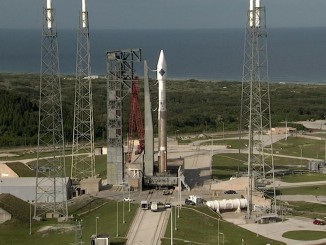
The first launch of Boeing’s Starliner space capsule aboard a United Launch Alliance Atlas 5 rocket has been delayed to Dec. 19, officials announced Tuesday.
The liftoff of the Starliner’s Orbital Flight Test on top of was previously scheduled for Dec. 17 on a week-long demonstration mission to the International Space Station. The mission is a critical precursor for the Starliner’s first flight with astronauts, a milestone Boeing officials say is scheduled for mid-2020.
“During pre-launch processing of the Atlas 5, there was an issue with the rocket’s purge air supply duct,” ULA said in a statement Tuesday. “Additional time was needed for the ULA and Boeing teams to complete an analysis of the issue, replace the duct and complete processing ahead of launch.”
The purge air supply duct is a new feature on the Atlas 5 rocket inside the launch vehicle adapter cavity, according to ULA. The adapter structure connects the Atlas 5 rocket with the Starliner spacecraft.
The duct is a tube that carries air from the ground environmental control system into the launch vehicle adapter cavity for pre-launch cooling of avionics and the Starliner service module, ULA said.
Liftoff time Dec. 19 is scheduled for roughly 6:59 a.m. EDT (1159 GMT), approximately 10 minutes before sunrise. The exact launch time will be determined closer to launch day based on the latest tracking of the space station’s orbit.
“We continue to work closely with Boeing to ensure that the Starliner flies as soon as the spacecraft and launch vehicle are ready,” ULA said.
Boeing is developing the Starliner crew capsule under a $4.2 billion contract awarded by NASA in 2014. NASA has tapped Boeing and SpaceX to develop new human-rated spaceships to end U.S. reliance on Russian Soyuz crew ferry ships to transport astronauts to and from the space station.

ULA has assembled the Atlas 5 rocket over the last month inside the Vertical Integration Facility just south of pad 41. Technicians first stacked the Atlas first stage on its mobile launch platform inside the VIF, then added two strap-on solid rocket boosters Nov. 6 and Nov. 7. The Atlas 5’s dual-engine Centaur upper stage was hoisted atop the rocket Nov. 8, followed by a sequence of checkouts on the launcher before Boeing’s Starliner crew capsule arrived for installation on the launch vehicle Nov. 21.
The Atlas 5 will ride its mobile launch platform for the 1,800-foot journey to pad 41 Wednesday, where ULA has built a crew access tower and white room to allow astronauts to board the Starliner through its side hatch.
Two trackmobile railcars will power the journey on rails from the VIF to the launch mount at pad 41.
ULA, Boeing and NASA teams are gearing up for the Integrated Day-of-Launch Test, or IDOLT, exercise to practice launch day procedures ahead of the Starliner’s first space mission.
The Atlas 5 launch team has lengthened the countdown for Starliner missions to more than 11 hours from its standard duration of early seven hours. The extra time allows a “blue team” of specialists — analogous to the space shuttle-era closeout crew — to assist astronauts in boarding the Starliner spacecraft after the Atlas 5 is fueled with cryogenic propellants.
The test “will give us the opportunity to deploy the crew access arm and verify all the access tower and arm interfaces with the spacecraft,” said Caleb Weiss, ULA’s mission manager for the Starliner program. “We will fully tank the vehicle, and we will have people out there at the pad that will be simulating day launch operations, just like they will be for a real launch day.
“So they will be in the white room, they’ll open up the hatch of the Starliner,” Weiss said in an earlier interview with Spaceflight Now. “They will practice going in and out, loading cargo, configuring Starliner for flight. So it’ll be a really good end-to-end system checkout of all the launch vehicle and spacecraft systems working together, as well as the people who are executing the operations.”
Once the IDOLT exercise is complete, the rocket will return to the VIF for additional testing and preparation activities ahead of liftoff later this month.
Email the author.
Follow Stephen Clark on Twitter: @StephenClark1.



